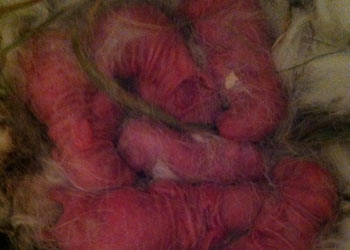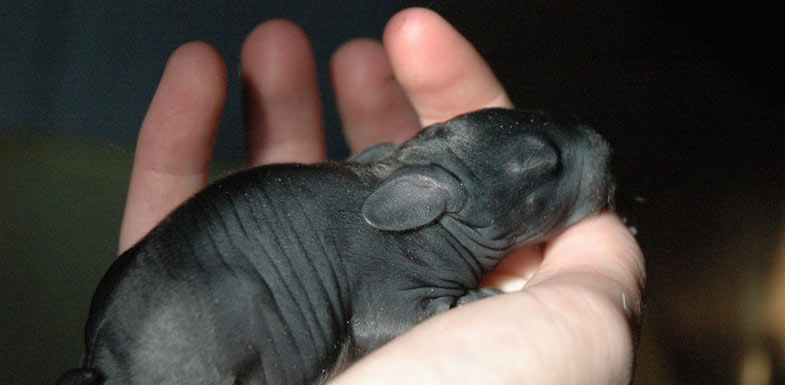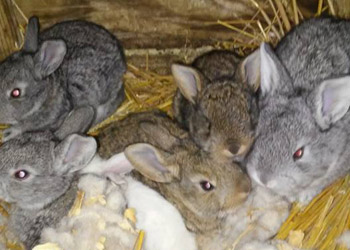Congratulations! You are the proud bunny-parents of one of the oldest & largest breeds of rabbit in the world. With that said, you have officially joined the ranks of Flemish Giant breeding. Now what? As you know by this point, giant babies are born small & completely defenseless. They are naked, with eyes & ears closed, & fully dependent on their giant mom and you to provide for them entirely. The worrying and fussing over, as well as a devout adoration of your kits is well under-way.
First days after birth

This is what new born Flemish Giants look like!
For the first few days all the babies will do is eat, sleep, & use the bathroom – which mom will also stimulate happening, after each feeding – twice a day; being in the morning & at night. You typically will not witness much, if any, of this happening. In case you are wondering, your doe will be fine with you checking the babies, & touching them will not affect her caring for them at all. So do not be afraid to handle & closely examine them, ideally on the average of 1-2 times every day. In addition, you might be asking “how do I really know if they are being fed?” The answer is that fed babies will have fat little bellies, with skin that is fairly taught and smooth. If not being fed, their little bellies will look somewhat skinny, may appear somewhat sunken in, and their skin will be quite wrinkled.
If you find one that appears to have not been fed, then you will need to step up to the plate immediately and help out. You do this by taking that kit (one at a time, if there are more than one in this condition) out of the nest box and set it down in a safe & secure spot next to where you can be sitting, then get Mom out. Sit down, roll mom over onto her back – remember to do this correctly, being mindful of her hind feet, & place the kit on her stomach so that its’ mouth is next to or over a teat. If the baby does not latch on, you may then need to coax it to do so; rub its mouth over the teat, & in more severe cases you may even need to very gently try to open its mouth to get it to eat.
The truth is that if the kit is at that stage, there is a very low chance of survival, but there is a slim chance that it will pull-through. While it is unfortunate & not a pleasant experience by any means, it is very common to loose 1-3 kits per every litter. Quite simply, the law of natural selection is part of breeding; the strongest will survive and the best of those will thrive. However, if you find an entire litter of kits that have not been fed, you must act fast –as you will have two options: find another doe that is nursing a litter & try to foster the babies over to that doe, or hand-rearing. While it may sound like an easy thing to do, hand-feeding babies is no where near as easily done, or successful, as what it may sound to be, but it can be done.
We suggest that you also visit our FAQ section which includes a lot of tips and answers the most common Flemish Giant questions. Moreover, this section covers multiple food related questions.
First two weeks after birth
Once your kits have reached 3-4 days of age, the biggest worries of them freezing are over. By this time, they have learned how to nurse & they are growing. At this age, their fur also comes in and they are starting to be more active too. In fact, you can relatively breathe easily from this point up through the following two weeks. Once the kits are on the average of 10-14 days old, their eyes will open. This is when the level of activity will definitely increase; especially as they learn how to hop out of the nest box & start roaming around the hutch with Mom. During this stage, add extra hay for them to munch on, and make sure you safe guard the sides of the hutch, especially if made of wire, as those not-yet-giant Giants can squeeze thru tight spots, ending in detrimental results.

Isn’t this black youngster very cute?
3-8 weeks after birth
The next wave of changes arrives when the babies are about 3 weeks of age. They are taking on more Flemish characteristics, displaying their own personalities, plus discovering what Mom has in those funny looking containers… feed. Here is your next stage of worry! Big bunnies have big appetites, they should be supplied with unlimited water, hay, & feed at all times; but with that can come big belly trouble. Be sure to check the kits every single day for signs of enteritis, commonly referred to as “bloat.” This will be covered in greater detail in the health section of this site, but for now – the symptoms to watch out for are a swelled (slightly ballooned) belly, lack of appetite, listlessness, poo-ey butts, as well as any signs of diarrhea. At the first signs of trouble, remove the effected kit & isolate it from all the others. Stop all access to regular feed, & give lots of clean, fresh hay & water. If your baby shows no interest in the hay within an hour or so, then call your vet if at all possible.

Few weeks old
Otherwise, Flemish kits are not much different than caring for any other rabbit. Daily checks and care must not be over-looked. Be mindful of even of the slightest changes in personality, activity, and appetite… and have fun spoiling your grand-bunnies.
OTHER MUST READ ARTICLES:+ : Costs of owning a flemish giant
+ : Grooming a flemish giant
+ : Sexing a flemish giant

